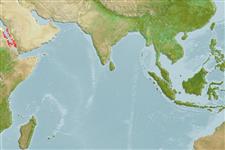>
Blenniiformes (Blennies) >
Tripterygiidae (Triplefin blennies) > Tripterygiinae
Etymology: Enneapterygius: Greek, ennea = nine times + Greek, pterygion = little fin (Ref. 45335); qirmiz: Name from the Arabic word "Qirmiz" for deep red or crimson, referring to the colour of the species; noun in apposition.
Environment: milieu / climate zone / depth range / distribution range
Ekologi
laut dasar (demersal); kisaran kedalaman 0 - 9 m (Ref. 88983). Tropical; 27°N - 13°N, 36°E - 43°E
Western Indian Ocean: Red Sea, Gulf of Aqaba, at Ras Mohammad and Ethiopia and off Yemen; the species is widespread, though not common in the Red Sea.
Size / Weight / umur
Maturity: Lm ? range ? - ? cm
Max length : 1.7 cm SL jantan/; (Ref. 88983)
deskripsi pendek
Kunci identifiaksi (pengenalan) | Morfologi | Morfometrik
Duri punggung (Keseluruhan (total)) : 15 - 16; duri punggung lunak (Keseluruhan (total)) : 9; Duri dubur: 1; Sirip dubur lunak: 17 - 18; vertebrata, bertulang belakang: 33 - 34. This species is distinguished by the following characters: small sized with a maximum recorded SL of 25.3 mm; D1 III, D2 XII-XIII, D3 9, first dorsal fin about the same height as the second; A I,17; pectoral fin 14; nape scaled; both sexes with characteristic oval patch of melanophores on dorsum between third and fourth dorsal-fin spines, males with large rectangular blotch of melanophores and brown pigment on side below posterior of second dorsal fin; red in life, with first dorsal of males crimson in front with golden yellow marks, white behind, base of fin a white patch on dorsum (Ref. 88983).
Adults are found in environments very similar to E. obscurus. They also commonly occur in isolated reefs far from coasts wherein other Enneapterygius spp. could not be found (Ref. 88983). Eggs are hemispherical and covered with numerous sticky threads that anchor them in the algae on the nesting sites (Ref. 240). Larvae are planktonic which occur primarily in shallow, nearshore waters (Ref. 94114).
Holleman, W. and S.V. Bogorodsky, 2012. A review of the blennioid fish family Tripterygiidae (Perciformes) in the Red Sea, with description of Enneapterygius qirmiz, and reinstatement of Enneapterygius altipinnis Clark, 1980. Zootaxa 3152:36-60. (Ref. 88983)
Status IUCN Red List (Ref. 130435: Version 2024-1)
ancaman kepada manusia
Harmless
penggunaan manusia
Perikanan: tidak ada kepentingan
Alat, peralatan
laporan khas
muat turun XML
Sumber internet
Estimates based on models
Preferred temperature (Ref.
123201): 27.8 - 29.3, mean 29 °C (based on 91 cells).
Phylogenetic diversity index (Ref.
82804): PD
50 = 0.5000 [Uniqueness, from 0.5 = low to 2.0 = high].
Bayesian length-weight: a=0.00955 (0.00304 - 0.03005), b=3.02 (2.77 - 3.27), in cm total length, based on LWR estimates for this (Sub)family-body shape (Ref.
93245).
Trophic level (Ref.
69278): 3.0 ±0.3 se; based on size and trophs of closest relatives
Fishing Vulnerability (Ref.
59153): Low vulnerability (10 of 100).
